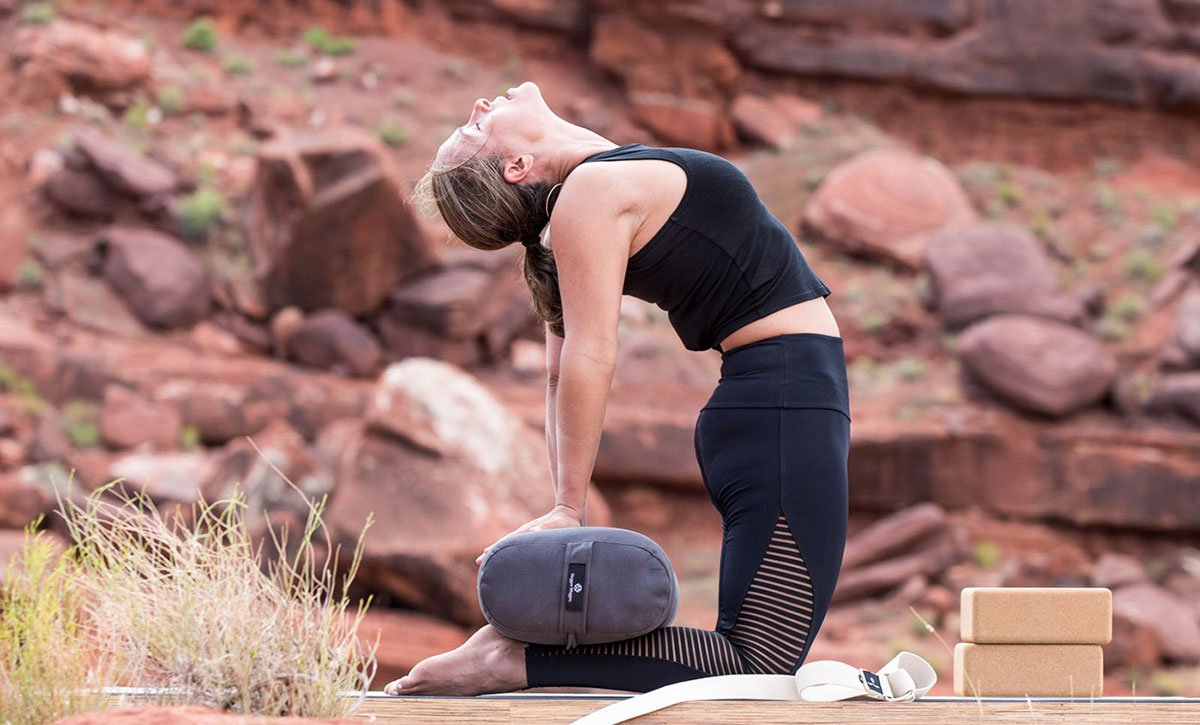This entry was posted on Sep 4, 2024 by Charlotte Bell.

Hatha Yoga is the combination of postures and breathing practices. For centuries, the Hatha Yoga Pradipika defined physical yoga practice. Most of the 15 poses described in the text are seated postures, with one lone backbend, Dhanurasana (Bow Pose). As yoga has adapted to modern life, however, backbends have become ever more important. This post will feature one of yoga’s emblematic backbends, Ustrasana (Camel Pose).
Practicing backbends is important because of the thoracic spine’s tendency to slump forward over time. It’s understandable. Most of our daily life activities require that we bend forward—over electronic devices, countertops, steering wheels, etc. Add to that the tendency for gravity to pull us forward over time. Regular backbending can help us stay upright.
It’s important to point out that the thoracic spine is not actually designed to extend (backbend). When we practice backbends, it’s the lumbar spine that is actually doing the backbending. But there are things we can do to make sure we don’t overuse the lumbar. We do this by preparing other areas of the body properly before we attempt Camel Pose, or any backbend.
How to Prepare for Ustrasana
It’s important to warm up before practicing any backbend. Here are the actions that can prepare us for practicing Ustrasana, along with poses that support these actions:
Cautions for Ustrasana
Be aware that Ustrasana is not a healthy pose for every individual. Please avoid this pose if you have high blood pressure or severe fatigue. Here are some other cautions and contraindications from Yoga Journal:
- Avoid or modify if you feel any pinching or pain in your low back.
- Avoid or modify if you have any shoulder pain, shoulder arthritis, or shoulder injuries.
- Avoid or modify if you have any back pain or injuries, including surgeries.
- For most, it is best not to drop your head back in this pose, particularly if you have a neck injury or are at risk for stroke. Instead, lift your chin slightly and use your neck muscles to stabilize your head in place. You can even draw the chin in toward the chest.
- Avoid or modify if you have shoulder injuries or pain in the pose.
How to Practice Ustrasana
After you’ve spent some time preparing your body, you’ll likely be ready to try Ustrasana. This version will use a yoga bolster across the calves to help you get maximum lift and lengthening in the spine.
How to Prepare
- Begin by sitting on your heels on a yoga mat. If your knees will not allow this, feel free to place a rolled blanket or block under your hips to start.
- Take a moment to feel your body. What is the character of your energy? Slow or quick? Downward or upward moving? Calm or agitated? There’s no need to try to “correct” what you feel; simply notice what is present.
- Press your knees and shins into the floor to lift your hips off the heels, bringing you to a kneeling position, with your pelvis directly over your knees.
- Place a yoga bolster across your calves.
Proceed to Camel Pose
- Place your hands on your pelvic rim. Ground your knees and shins, lifting your sternum toward the sky, so that your low back lengthens. From this lengthening, root your pelvis right over your knees (don’t let it fall back toward your heels), and begin to bend back from the waist. Keep lengthening your spine as you bend back.
- Reach your hands back behind you and place them on your bolster. Breathe and expand.
- Stay here, breathing fully, for 5 to 10 breaths.
- Press your knees into the floor to help bring your body back to upright. Release both arms to your sides and return to sitting on your heels or your block or bolster.
- Close your eyes and be aware of your body’s energy. Has anything shifted?
- If your lumbar is flexible in backbends, you can do this again, placing your hands on your heels instead of the bolster. If you try this and find that your breathing is restricted or your pelvis collapses back over the feet, return to an upright position and practice again with a bolster. Also, feel free to move on to the next step.
- After practicing Ustrasana, practice Jathara Parivrttanasana (Revolved Belly Pose). Then practice at least one seated forward bend to stretch the back body and settle your nervous system. Finish with Savasana (Relaxation Pose).
About Charlotte Bell
Charlotte Bell discovered yoga in 1982 and began teaching in 1986. Charlotte is the author of Mindful Yoga, Mindful Life: A Guide for Everyday Practice and Yoga for Meditators, both published by Rodmell Press. Her third book is titled Hip-Healthy Asana: The Yoga Practitioner’s Guide to Protecting the Hips and Avoiding SI Joint Pain (Shambhala Publications). She writes a monthly column for CATALYST Magazine and serves as editor for Yoga U Online. Charlotte is a founding board member for GreenTREE Yoga, a non-profit that brings yoga to underserved populations. A lifelong musician, Charlotte plays oboe and English horn in the Salt Lake Symphony and folk sextet Red Rock Rondo, whose DVD won two Emmy awards.

